1. Fluency
The goal of reading instruction is for students to demonstrate comprehension of what they read. Comprehension is achieved most easily through fluent reading. “Fluency refers to reading words quickly and accurately, but also with proper intonation or prosody. Prosody comes from two Greek words, pros, meaning “to” or “toward” and ode, meaning a song (hence the English word ode). Just as songs vary their pitch, so do readers vary their intonation as they read. Such prosody suggests that the reader comprehends the passage as she reads it, otherwise she would not likely know when to inflect her voice (Schwanenflugel & Ruston, 2008; Whalley & Hansen, 2006).” (Kilpatrick pg. 121)
Fluency is often thought to improve from repeated readings of a passage. This is based on the idea that a student who is struggling to read material will improve with more exposure to the words. We have all had the experience of rereading difficult text in order to make sense of it. However, sometimes the underlying cause of the disfluent reading is an inability to decode the words or is because the vocabulary or text structure is too challenging. If that is the case then repeatedly rereading the same material over and over is not likely to greatly improve fluency.
The Simple View Of Reading
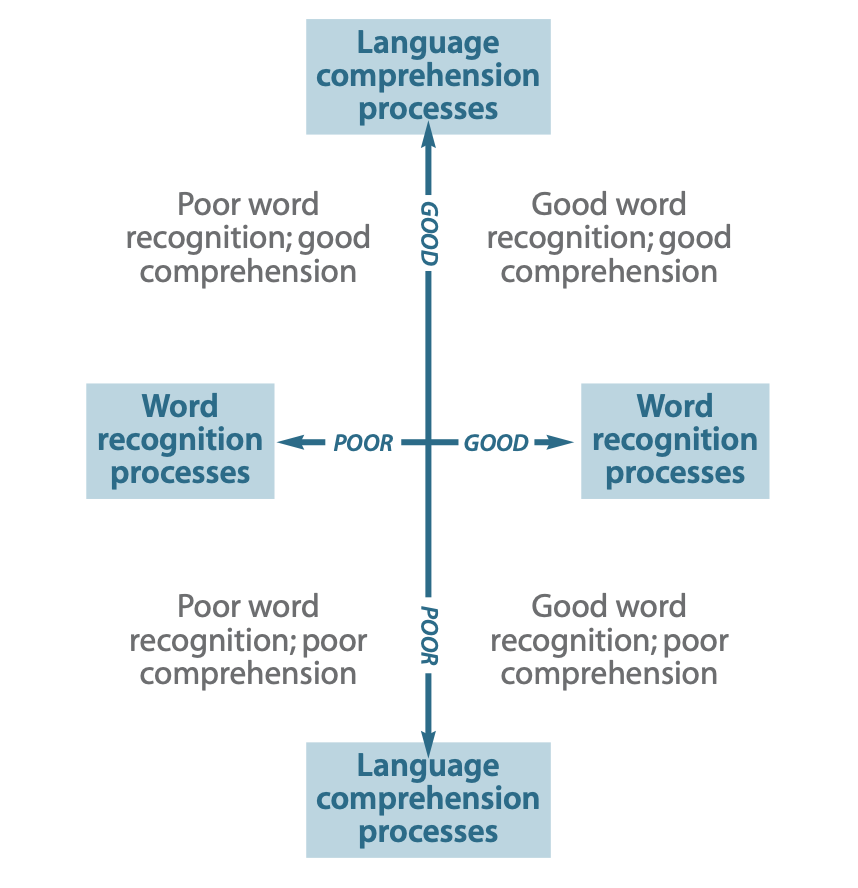
The Simple View of Reading
(image taken from the The Rose Report, 2006)
(image based on the work of Gough & Tunmer, 1986)
The image above is called The Simple View of Reading (Gough & Tunmer, 1986). Reading is a product of the skill of word decoding and the skill of understanding what the words mean. The word “product” is important here for its meaning of something created from effort and for the mathematical sense of multiplication. The end result of reading comprehension arising from decoding and language comprehension is not like an addition sentence where one plus one equals two. It is more like a multiplication sentence because having either weak decoding or weak language comprehension will equal poor or nonexistent reading comprehension.
Example #1: If you can decode the words on the page but you don’t understand what the words mean, perhaps the vocabulary is too complex or you are reading about a subject you do not have enough background knowledge on, then you will have no reading comprehension. 1 x 0 = 0
Example #2: If you choose reading material you are familiar with and that has vocabulary you understand, you will not achieve reading comprehension if you cannot sound out the words on the page. 0 x 1 = 0

The simple view of reading is simple only on its surface. The two broad categories of decoding and language comprehension encompass a large array of subskills needed in order to be able to read. Dr. David Kilpatrick offers a comprehensive breakdown of these skills in Chapter Three of his Book Essentials of Assessing, Preventing, and Overcoming Reading Difficulties. He writes that research has continued to explore the two subsections of the simple view of reading in the decades since it was first proposed. Those years of research have found evidence for the reading subskills below.
The subskill of Cipher Knowledge in decoding requires mastery of: (Kilpatrick pg. 64)
– letter-sound/orthographic knowledge
– phonological awareness
– phonological blending
– working memory
– morphological knowledge/awareness
– vocabulary/phonological long-term memory
– rapid automatized naming
– visual/phonological paired-associate learning
The subskill of Word Knowledge in decoding requires mastery of: (Kilpatrick pg. 71)
– cipher skills/phonic decoding
– phonemic awareness
– vocabulary/phonological long-term memory
– working memory
– rapid automatized naming
– morphological knowledge/awareness
Linguistic Comprehension requires mastery of: (Kilpatrick pg. 73)
– vocabulary-semantic knowledge
– syntactic-grammatical knowledge
– background knowledge
– working memory
– attention
– inference
– comprehension monitoring
– nonverbal visual-spatial skills
This list of skills is comprehensive and specific. If you have read other pages of this blog, you have probably noticed that we find infographics helpful. The next section presents a beautifully crafted visual that organizes all of these reading skills in an approachable and understandable manner.
The Reading Rope
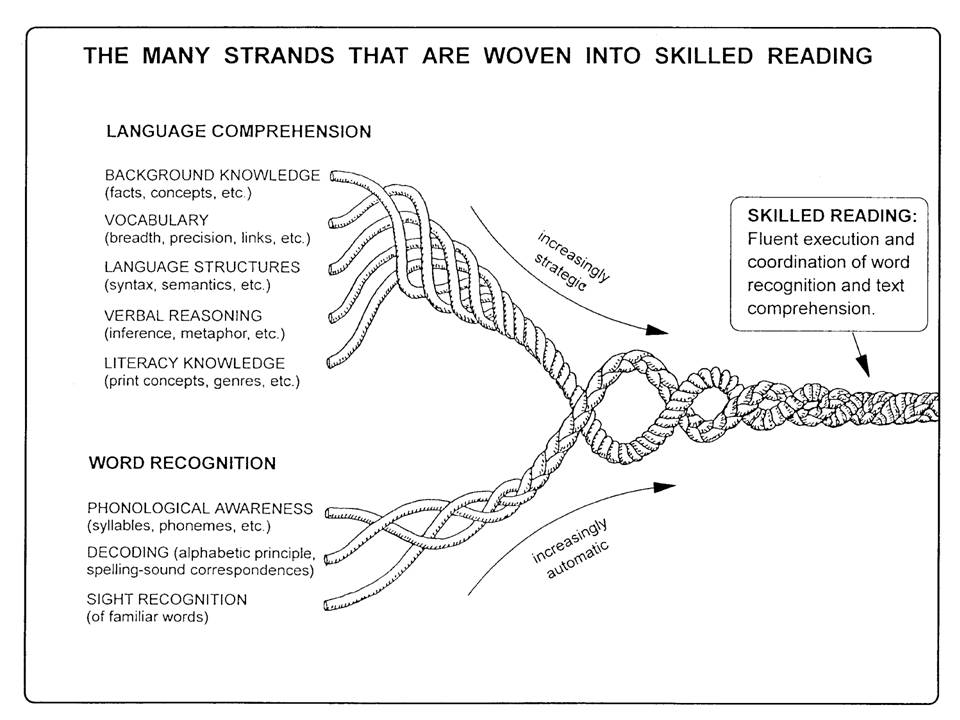
(taken from International Dyslexia Association)
The Reading Rope succinctly illustrates what is needed in the teaching and learning of reading. The bottom section of the Reading Rope shows the decoding part of the simple view of reading. The top of the Reading Rope shows the language comprehension part of the simple view of reading. All grades teach all of the reading skills. However, different stages of reading require varying amounts of time and practise on these skills. Details of our programming for Word Recognition and Language Comprehension can be found on their respective blog pages.
Fluency
Once students are able to decode words, and when they have an age appropriate understanding of the English language, we expect them to be able to read fluently. Fluency is not a skill by itself, rather it is an outcome produced from many skills together. Fluency can be described with the following formula:

When a student reads smoothly, with expression, with pauses in the right places to show phrasing, and at an appropriate speed they are said to be doing prosodic reading. They are decoding easily and they are showing with their tone of voice that they accurately understand the meaning of the words. Just like the simple view of reading, if one of these elements of reading is not secure enough it is like a zero in a multiplication equation and the result will be disfluent reading. Below is rubric further detailing the many elements needed for fluent reading:
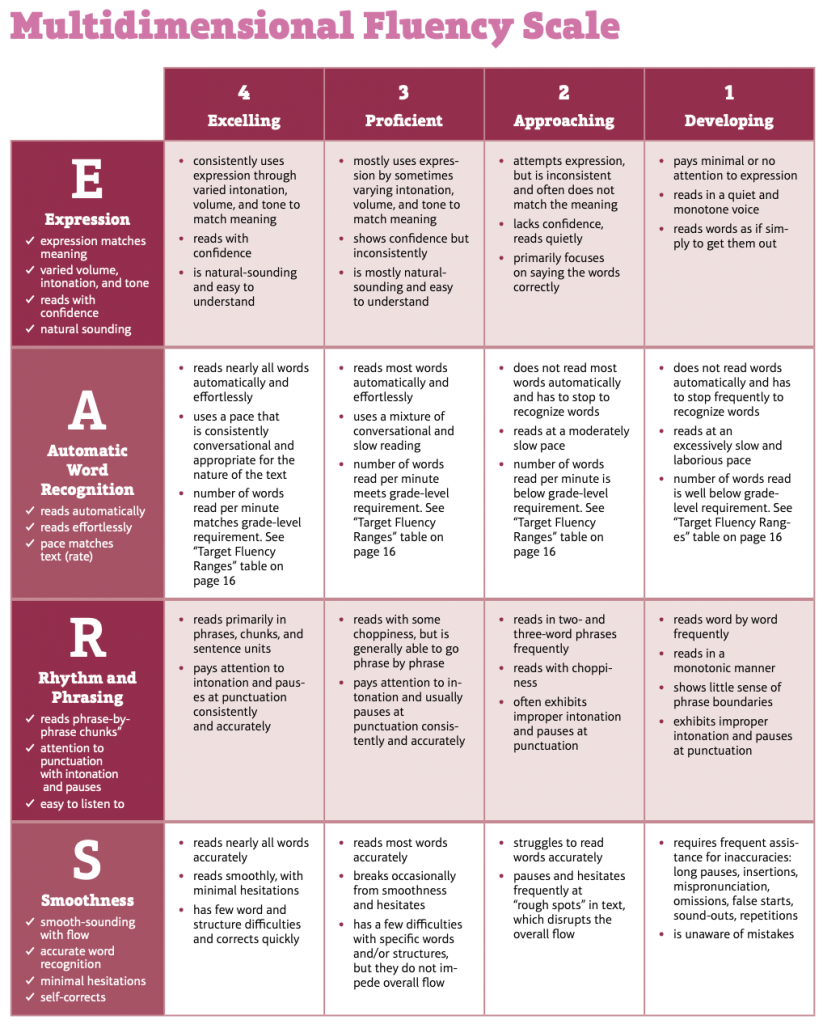
Timothy V Rasinski & Melissa Cheesman Smith
Reading proficiently with expression, automatic word recognition, rhythm, phrasing, and smoothness supports deep comprehension of what is being read. This, in turn, “leads to greater levels of interest and motivation for reading for all readers (Rasinski, 2010, 2012), especially those who are experiencing difficulty (Rasinski, 2017).” (MegaBook of Fluency pg. 9-10)
Fluency is sometimes mistaken to mean reading quickly. This is because many fluency assessments have a timed component. The Hasbrouck & Tindal Oral Reading Fluency norms below are based on how many words are read correctly in one minute. Dr. Rasinski explains: “we know that fluency isn’t all about speed, but it’s a part of it, because slowing down to decode negatively impacts comprehension.” (MegaBook of Fluency pg 15)
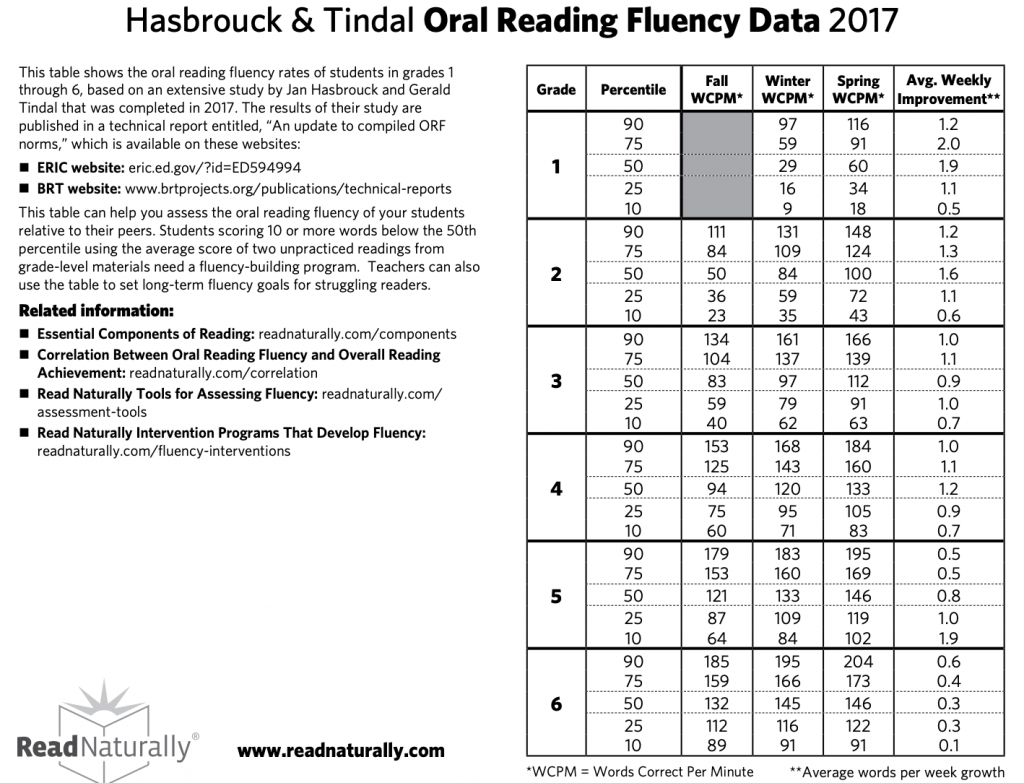
(public access download from readnaturally.com)
Fluency is complex and both students and teachers need to be aware of the many elements that need to be mastered for fluent reading to occur. Students need to hear fluent reading often (from both adults and reading partners), they need to read a wide variety of texts, and they need to reread a text if they are experiencing difficulty with it. (MegaBook of Fluency pg 11-12) “…fluent readers think about words and phrases to emphasize and places to pause, increase volume, change pitch and tone. Why? To make the reading more engaging and meaningful.” (MegaBook of Fluency pg 38)
Teachers use a great variety of activities in order to teach fluency: nursery rhymes, songs and poetry teach rhythm and phrasing; saying words with differing emphasis, practising with synonyms, and playing with punctuation teaches expression and tone; and group reading, chants, and tongue twisters teach smoothness. Students find these activities engaging and effective for developing fluency.
A very short summary
1. Fluency is reading appropriately quickly with accuracy and expression.
2. The Simple View of Reading says: Decoding x Language Comprehension = Reading Comprehension
3. There are many subskills within Decoding and Language Comprehension.
4. The Reading Rope infographic displays categories of skills needed for effective reading.
5. Fluency can be understood with the following formula: Word Automaticity x Prosody = Fluency
6. Fluency subskills are expression, automatic word recognition, rhythm and phrasing, and smoothness.
7. The skills required for fluent reading need to be modelled and explicitly taught.
References

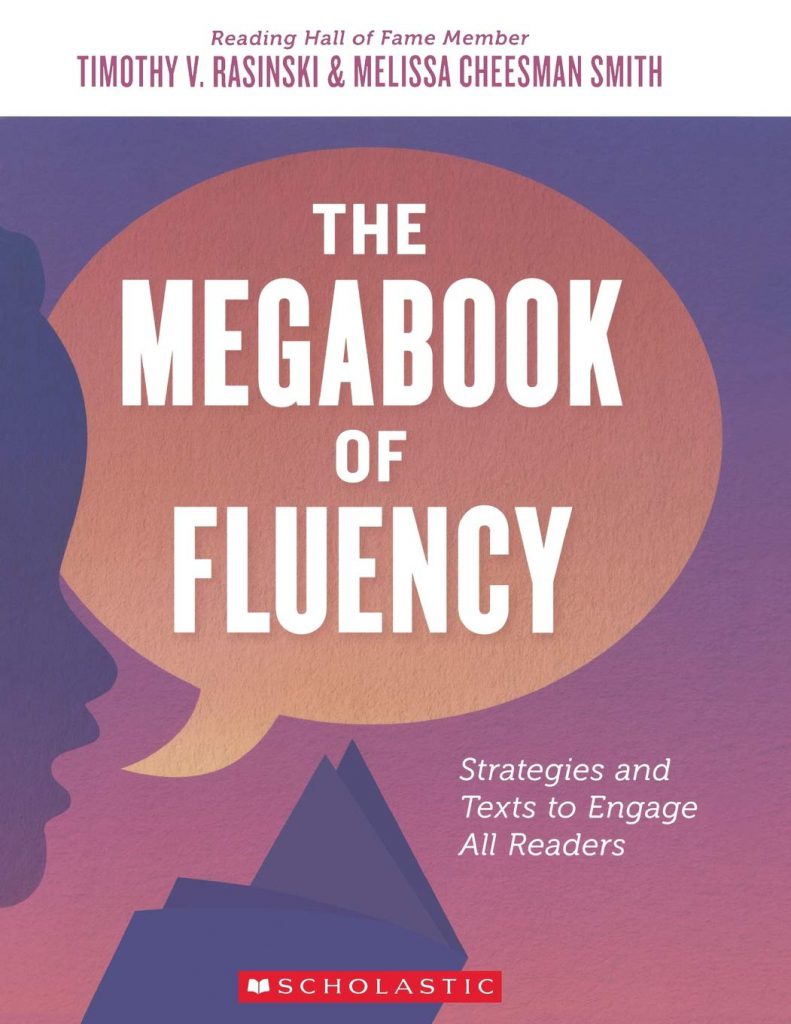
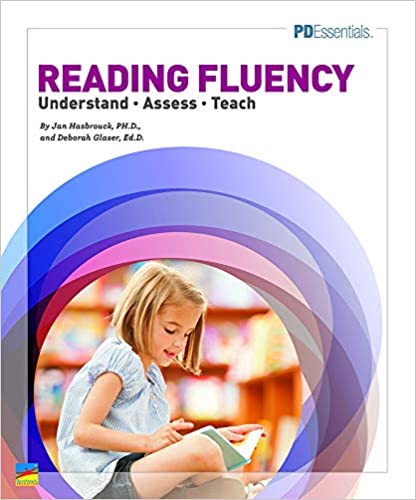
Gough, P. B., & Tunmer, W. E. (1986). Decoding, reading, and reading disability. Remedial and Special Education, 7, 6-10.
The Rose Report Department for Education and Skills (2006). Independent Review of the Teaching of Early Reading, Nottingham, UK: Author. Retrieved from The Reading League https://www.thereadingleague.org/knowledge-base/
Scarborough, H. S. (2001). Connecting early language and literacy to later reading (dis)abilities: Evidence, theory, and practice. In S. Neuman & D. Dickinson (Eds.), Handbook for research in early literacy (pp. 97–110). New York, NY: Guilford Press.
Read Naturally (research based reading interventions):
https://www.readnaturally.com/knowledgebase/featured-topics
Related Reading
CANADIAN: National Strategy for Early Literacy (2009). The Canadian Language and Literacy Research Network. Retrieved from
CANADIAN: Foundations for Literacy: An Evidence-based Toolkit for the Effective Reading and Writing Teacher (2009). The Canadian Language and Literacy Research Network. Retrieved from
The National Reading Panel Report (2000) National Institute of Child Health and Human Development. Report of the National reading Panel. Teaching Children to Read: An evidence-based assessment of the scientific research literature on reading and its implications for reading instruction: Reports of the subgroups (NIH Publication No. 00-4754). Washington, DC: U.S. Government Printing Office.
National Early Literacy Panel (NELP). (2008). Developing early literacy: Report of the National Early Literacy Panel. Washington, D.C: National Institute for Literacy.